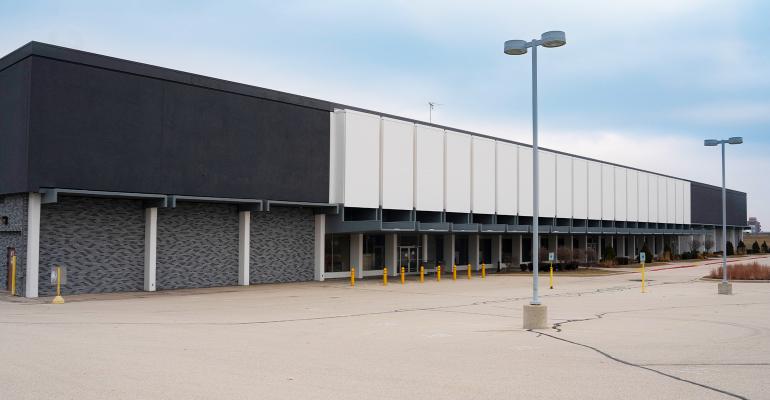Sponsored by Frank P. Crivello
Simon Property Group, Inc., the largest shopping mall operator in the United States, has entered into talks with Amazon about converting unused shopping mall space into distribution centers (DCs), according to a recent report from the Wall Street Journal. With the retail sector expected to lose up to 25,000 stores in 2020, the Amazon news is only one small part of larger discussion about converting unused commercial spaces into much-needed industrial real estate. While the COVID-19 pandemic has caused retail stores and offices to shut their doors, an e-commerce boom has left the U.S. logistics sector scrambling for access to additional distribution and cold storage space.
On the surface, converting malls into DCs and warehouses seems like a great idea. Malls are conveniently located near population centers and tend to have spacious ceilings that should be well-suited to racking and material handling systems. As with any commercial property conversion, however, turning shopping mall units into DCs will not happen without overcoming some challenges.
1. Zoning
Shopping malls aren’t usually zoned for industrial use. Industrial facilities are loud and bring in a significant amount of heavy truck traffic. Zoning restrictions will vary widely at the state and local level depending on the mall’s geographic location. Convincing a planning board or city council to modify the land use permissions for a large commercial area such as a shopping mall may not be easy—especially if that mall is surrounded by residential properties. For some areas, the promise of jobs and economic stimulation may be enough to sway the decision-makers, but it’s likely that many areas will not be willing to rezone.
2. Sharing
While multi-tenant logistics facilities are nothing new, it’s rare for a distribution center to share a facility with retail tenants. The discussions between Amazon and Simon Property Group seem to be focused on occupying abandoned J.C. Penney and Sears stores. If the rest of the mall remains occupied by dozens or more retailers, new processes and planning will be required to mitigate the risk of negative business impacts.
Here are some examples of potential problems that property owners would need to account for:
- A steady flow of large delivery vehicles and semi-trucks might make commercial shoppers nervous and deter them from visiting other stores in the mall complex.
- An industrial facility may have dozens or hundreds of employees on a single shift. Retailers in the mall would want owners to ensure those workers don’t monopolize preferential parking, while the DC tenant may prefer their employees to park close by.
- While mall security focuses on loss prevention and customer safety, security at a distribution center has different needs.
While none of these issues are necessarily deal-breakers, it’s important that commercial property owners, existing retail tenants, and new industrial tenants address concerns up front to establish good business relationships.
3. Renovations
Though any new retail tenant in a mall would need to renovate the space to some degree, the level of renovation required to convert a former clothing retailer or electronics store into a functional distribution center would be more extreme. For example, concrete floors in retail stores may only be 3” to 4” thick while a warehouse may need to be 6” or more. Parking lots and driveways also have the same potential issue; asphalt for a retail parking lot is not as thick as needed for constant heavy truck access. There may also be limitations to the type of equipment the industrial operator would be able to use. For example, installing conveyors or other permanent material handling systems may not be feasible. Fortunately, recent advances in picking robotics and wearable technologies might make it possible to implement automation without permanent installations. If the mall only has a single loading dock area for all tenants to share, a distribution center would likely monopolize that area with its stream of inbound and outbound shipments, so additional docks would need to be added.
Benefits
While there are certainly challenges, operating a DC out of a mall does have some benefits:
- The employees from the distribution center are likely to shop at stores in the mall on breaks and before and after work, which will be a boon to struggling businesses.
- Most malls are conveniently located within minutes of major highways and already have large, accessible parking lots. This should facilitate easy access for inbound and outbound truck drivers.
- If the mall has lost some of its large anchor tenants, it’s likely that the community will benefit from the jobs provided by a distribution center.
About Phoenix Investors
Founded by Frank P. Crivello in 1994, Phoenix Investors and its affiliates (collectively “Phoenix”) are a leader in the acquisition, development, renovation, and repositioning of industrial facilities throughout the United States. Utilizing a disciplined investment approach and successful partnerships with institutional capital sources, corporations, and public stakeholders, Phoenix has developed a proven track record of generating superior risk-adjusted returns, while providing cost-efficient lease rates for its growing portfolio of national tenants. Its efforts inspire and drive the transformation and reinvigoration of the economic engines in the communities it serves, currently encompassing over 30 million square feet. Phoenix continues to be defined by thoughtful relationships, sophisticated investment tools, cost-efficient solutions, and a reputation for success.





